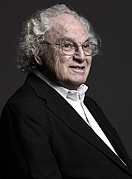News
Nobel laureate Hauptman dies at 94
Herbert A. Hauptman—eminent mathematician, Nobel laureate and UB emeritus faculty member—died Oct. 23. He was 94.
Hauptman became Western New York’s most important scientist ever after he and colleague Jerome Karle received the Nobel Prize in Chemistry in 1985 for developing mathematical methods for deducing the molecular structure of chemical compounds.
“The University at Buffalo community is deeply saddened by the passing of Dr. Herbert Hauptman, one of the most eminent and influential faculty members in UB’s long history, and widely considered to be the most important scientist ever to have lived in Western New York,” said President Satish K. Tripathi.”Our heartfelt condolences and sympathies are with the entire Hauptman family.
“Truly, Dr. Hauptman embodied everything we mean when we speak of faculty excellence—certainly by virtue of his international stature as a Nobel laureate and as a member of the National Academy of Sciences, but on an even more profound level by virtue of his deep and abiding devotion to our academic community over the course of a long and distinguished career,” Tripathi said. “For over 40 years, he dedicated himself to enriching the world around him as a scholar, educator and mentor.
“A brilliant scholar whose achievements in the laboratory have made possible longer and healthier lives, Dr. Hauptman has helped to lead the way toward a host of critical medical breakthroughs. His groundbreaking work in the field of X-ray crystallography continues to have monumental implications for the design of therapeutic drugs to prevent and treat life-threatening diseases.”
Tripathi noted that through his pioneering contributions, Hauptman was instrumental in defining the field of biomedical research over the decades. “In the process, he also helped to establish our university and region as recognized leaders in this field worldwide. As president of the Hauptman-Woodward Medical Research Institute, he helped to build it into a world-renowned research center, one that continues to enrich our university today through our vital institutional partnership on the Buffalo Niagara Medical Campus,” he said.
“His impact on our university, on our Western New York region and on the scholarly community worldwide is immeasurable. He has left an indelible mark on the UB community over the past half-century—and it constitutes a lasting legacy for the future generations of scientists, students and scholars whose own lives will be changed by his achievements and contributions.”
A native of New York City, Hauptman received a bachelor’s degree from City College of New York and a master’s degree in mathematics from Columbia University in 1939.
In 1947, Hauptman began working with Karle—a classmate at CCNY—at the Naval Research Laboratory in Washington, D.C. While there, he earned a PhD in mathematics from the University of Maryland in 1955.
Hauptman, the mathematician, and Karle, a chemist, proved to be a good team. The men set out to directly determine molecular structures through the methodology of X-ray crystallography, a problem that had daunted scientists for decades.
They used mathematical probability theory to interpret the patterns formed in X-rays scattered from crystals, devising equations to translate the information in the X-ray patterns directly into a structural map that revealed the locations of individual atoms.
They first published their solution in 1953 in a book titled “Solution of the Phase Problem I: The Centrosymmetric Crystal.” But other scientists were skeptical of their work and it was largely ignored until finally being accepted in the 1970s, when crystallographers began using their methods to determine the three-dimensional structures of myriad biological molecules, many of which had medical significance.
Hauptman and Karle finally received the recognition they deserved with the awarding of a Nobel Prize in 1985.
Hauptman came to Buffalo in 1970, leaving the Naval Research Laboratory to join the crystallographic group at the Medical Foundation of Buffalo, a small, nonprofit biomedical research institute. He became MFB’s research director in 1972, and later its president. The institute was renamed Hauptman-Woodward Medical Research Institute (HWI) in 1994 to honor Hauptman and Helen Woodward-Rivas, the philanthropist who provided the seed funds for the institute.
Professor emeritus in the UB Department of Structural Biology and adjunct professor in the Department of Computer Science, Hauptman worked with his UB colleagues during the 1990s and early 2000s to improve his methods so that they could be applied successfully to much-larger molecules.
A member of the National Academy of Sciences, Hauptman received many honorary degrees from colleges and universities in countries as far away as Poland, Israel and Italy. Most recently, he received an honorary degree from SUNY at UB’s 2009 commencement.
The author of three books, his work also appeared in nearly 170 select peer-reviewed publications. He contributed chapters to at least 40 books and presented papers at more than 280 national and international meetings.
Hauptman continued to work daily at HWI into his 90s, working on his own research projects and serving as a mentor and teacher to younger scientists and staff members. As a hobby, he made stained-glass artwork inspired by mathematically defined, complex geometrical shapes. A permanent collection of his work resides at HWI.
A memorial service will be held at 4 p.m. Nov. 21 in the Center for the Arts, North Campus.


Reader Comments